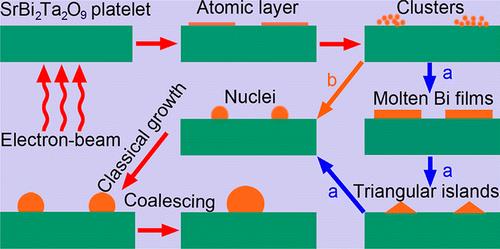Based on the previous work, researchers prepared SrBi2Ta2O9 (SBT) platelet by a molten salt route and used it as substrate for Bi nanoparticle growth. The experiment selected nanostructures anchored to the edge of the SBT platelet to ensure observation of the growth trajectories of the Bi nanostructures clear. They observed critical nuclei for the nanodroplets formed via adding atoms to the prenucleated clusters. The process achieved through indirect transformation of an intermediate liquid film which guided by the Stranski−Krastanov growth mode, and the liquid film was induced by the self-assembly of the prenucleated clusters.
They used a high resolution transmission electron microscope (HRTEM) to observe the growth of bismuth (Bi) nanodroplets from SrBi2Ta2O9 under electron-beam irradiation. Atomic scale imaging showed that such dynamics of nucleation are more complex than previously predicted based on classical nucleation theory (CNT), which was first studied by Gibbs for the nucleation of water droplets from condensation of vapor.
“This study allows us to visualize the critical steps in the nucleation process of an interfacial nanodroplet, which suggests a revision of the perspective of CNT.” said the author.
The results have been published in ACS Nano, which provide not only a promising approach to produce nanodroplets at nanometer range (<5 nm) but also a method to achieve in situ HRTEM observation on the growth dynamics of nanodroplets.
The work was supported by National Natural Science Foundation of China, the “Western Light” Program of CAS, and the CAS/SAFEA International Partnership Program for Creative Research Teams,etc.

Schematic Illustration of Overall GrowthTrajectories of the Interfacial Bi Nanodroplet.(Image by XTIPC)
Contact:
Prof. WANG Chuanyi; Dr. LI Yingxuan
E-mail:cywang@ms.xjb.ac.cn; yxli@ms.xjb.ac.cn
Xinjiang Technical Institute of Physics & Chemistry,CAS
